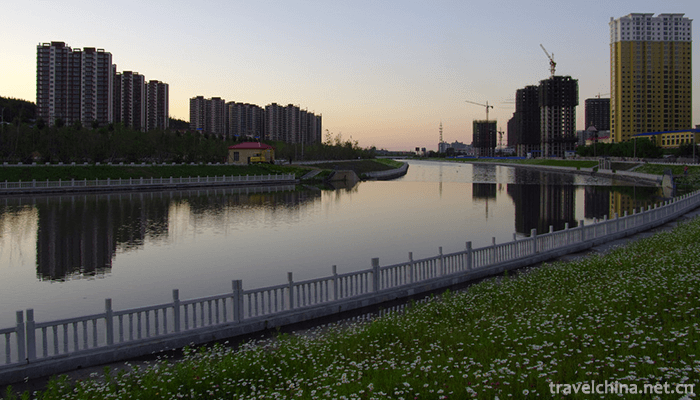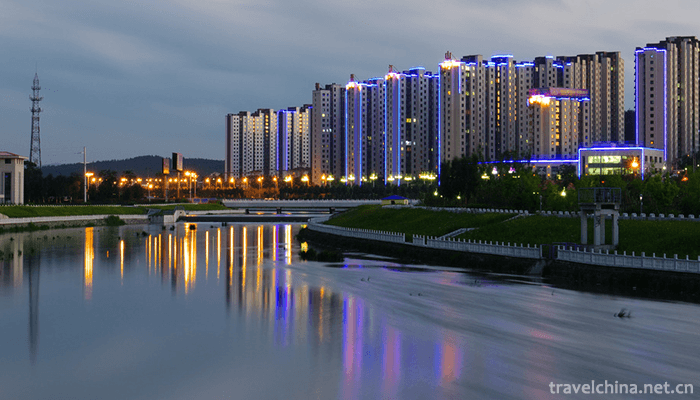Anbang River National Wetland Park is built on the basis of Anbang River Provincial Wetland Nature Reserve, which is located in Shuangyashan City, Heilongjiang Province, with a total area of 10295 km. In January 2001, it was approved as a provincial nature reserve, which belongs to inland wetland and aquatic ecosystem reserve.
In 2004, it was awarded the National AAA Scenic Spot, and in 2011 it was awarded the National AAAA Scenic Spot. It is the only national AAAA Scenic Spot in Shuangyashan City and the only 12 national wetland parks in China. In October 2011, it was officially approved as the first batch of national wetland parks in China. There are 403 species of vascular plants and 218 species of vertebrates in the reserve. Among them, there are 3 species of primary protected animals, namely red-crowned crane, white crane and black crane. There are 16 species of secondary protected animals, 6 species of amphibians, 165 species of birds and 7 species of mammals in the reserve.
Development history
Anbang River Wetland Nature Reserve is one of the most complete, representative and typical original wetlands in Sanjiang Plain. There are a large number of reed marshes and Carex camphor wetlands in the reserve. The diverse wetland environment provides good living conditions for vertebrates.
Anbang River wetland is rich in rare animals and biodiversity. It is a gene bank of biological resources. It was rated AAA scenic spot in 2004 and national AAAA scenic spot in 2011. It is the first and only national AAA AAA scenic spot in Shuangyashan City. It fills in the gap that Shuangyashan City does not have 4A scenic spot. In October 2011, it was officially approved as the first batch of national wetland parks in China, which is the only 12 national wetland parks in China. There are 403 species of vascular plants and 218 species of vertebrates in the reserve. Among them, there are 3 species of state-level protected animals, namely red-crowned cranes, white cranes and black cranes, 16 species of state-level protected animals, 6 species of amphibians, 165 species of birds and 7 species of mammals. A large number of waterfowl live here every year. More than 40 red-crowned cranes were recorded in September 2001, with the largest population of 12. In September 2002, 94 egrets, 2 Oriental white cheeks and thousands of geese and ducks were recorded to settle in the Anbang River wetland.
geographical environment
Anbang River Wetland Provincial Nature Reserve is located in the lower reaches of Anbang River, 45 kilometers northeast of Welfare Town, Jixian County Town, Heilongjiang Province, less than 60 kilometers away from Shuangyashan City. It has a flat asphalt road to the core area of wetland. The reserve covers an area of 10295 hectares. Among them, the core area is 3980 hectares, accounting for 38.7% of the protected area; the buffer area is 2436 hectares, accounting for 23.7% of the protected area; and the experimental area is 3879 hectares, accounting for 37.6% of the protected area.
Main attractions
Anbang River Wetland Park is a beautiful European-style villa building, simple wooden house, only for summer recreation. The highest point is the seventeen-meter bird-watching platform, inscribed with the words "climbing the telescope". The couplet says "no worries, green water rippling thoughts, listening to egrets leading to poetry". It looks up, has a broad vision, and has a panoramic view of all the tobacco, such as a wave of tobacco waves, billowing, white clouds in the distance, like splashing waves on the shore, "rolling up thousands of piles of snow", occasionally rushing out of the vast tobacco. Black wings, flying in the blue sky of freedom.
A 248-hectare Anbang River National Wetland Park has been built in the reserve, which is divided into five parts: ecological park, water park, amorous garden, bird-watching Park and park entrance. People can not help but be convinced by its ingenious idea and creativity. Here, every building, every sculpture, every sculpture, every woodcut, both simple and elegant, but also with modern colors, appears extraordinary.
The natural landscape in the park, which is dominated by various types of wetlands, blends with the humanistic landscape dominated by the folk culture of Beidahuang, laying a foundation for the development of natural ecology and folk culture leisure and sightseeing service activities in the park.
Especially the fishing and hunting culture, reclamation culture, educated youth culture and folk culture bearing historical symbols have formed the local historical and cultural characteristics with wetland as the carrier, which provides a variety of choices for the park to carry out wetland science popularization education activities. Nowadays, the park has built some service facilities to provide tourists with sightseeing, leisure, catering and entertainment in wetland area or periphery. It has occupied a place in the characteristic tourism market of Heilongjiang Province.
The man-made lake is a water playground. The mobile and pedestrian cruise boat looks like a duck or a goose, which is particularly novel and unique. Located on the east side of the pirate ship, the museum is a typical antique building. The museum is a comprehensive museum open to visitors and a provincial museum with large scale, more exhibits and complete service facilities.
The building area of the Missionary Hall is 3062 square meters, which consists of several functional halls. In the main exhibition hall, rockeries, pavilions, bridges, running water, reeds, verdant plants, rippling water, fish playing, birds contending, can be described as a concentrated version of the whole wetland landscape. 6 big
More than 100 specimens of wild birds in wetlands are placed in the eco-scenic box. All specimens in the hall can be seen along the circular swing road. There are four electronic touch screens in the hall. As long as you touch any of them at will, there will be computer language broadcasting to learn about wetlands. Here, while people personally appreciate the natural landscape such as tower head, moss, marsh, reed bed, grassland, wetland birds and animals, they will appreciate the unique humanistic landscape created by the Wetland Park designers with the idea of "integrating into nature". Simulated boutique landscape, cultural corridor, bird watching platform, pigeon building, bird park, zoo, fishing ground, lotus lake, water wharf, waterfall, tea house, singing hall, hotel, supermarket, artificial lake, pirate boat, farmyard restaurant, sports leisure and fitness square, northeast style hall, many beautiful scenery. Under the wetland wharf is a vast area of water, where a boat is swaying and flooding in the reed marsh, which has a special interest.


0 Questions
Ask a Question
Your email address will not be published.